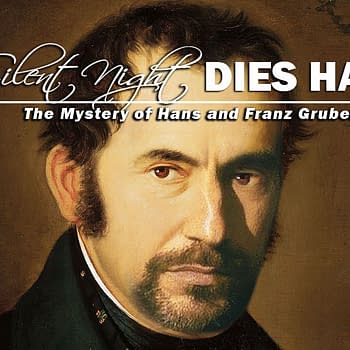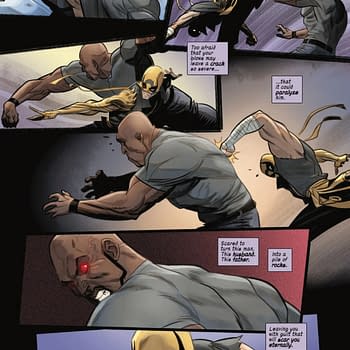Posted in: Comics, Recent Updates | Tagged: google, spirit, will eisner
Google Celebrates Will Eisner's 94th Birthday With The Spirit Google Logo
If it's March 6th where you are visit Google and you'll see a Google logo featuring Will Eisner's The Spirit and done in the style of his famous opening title pages. The search engine giant also invited Scott McCloud to do a post on the subject of Eisner's legacy for his 94th birthday (and if you are here from Google, read on to learn more!):
Eisner influenced comics in dozens of ways. In the '40s, Eisner's The Spirit—a seven-page newspaper feature—introduced an arsenal of visual storytelling techniques still used generations later, and provided an early testing ground for future comics stars including Jack Kirby and Jules Feiffer. (The Spirit also began a tradition of pictorially-integrated logos—inspiring today's snazzy rooftop doodle!)
Eisner was one of the first cartoonists to understand the power of visual education, and wrote eloquently about the process of making comics in Comics and Sequential Art (1985) and Graphic Storytelling (1996). As early as 1941, he publicly advocated treating comics as a distinct literary and artistic form, and—nearly four decades later—was instrumental in the rise of the graphic novel in America, beginning with A Contract with God in 1978.
For most of his career, Eisner was years, even decades, ahead of the curve. I saw him debating artists and editors half his age, and there was rarely any question who the youngest man in the room was. It helped that he never stood on ceremony. Everyone was his peer, regardless of age or status. None of us called him "Mr. Eisner." He was just "Will."
And a little more background from willeisner.com, if you'd like to know more about Eisner:
WILL EISNER was born William Erwin Eisner on March 6, 1917 in Brooklyn, New York. By the time of his death on January 3, 2005, following complications from open heart surgery, Eisner was recognized internationally as one of the giants in the field of sequential art, a term he coined.
In a career that spanned nearly seventy years and eight decades — from the dawn of the comic book to the advent of digital comics — he truly was the 'Orson Welles of comics' and the 'father of the Graphic Novel'. He broke new ground in the development of visual narrative and the language of comics and was the creator of The Spirit, John Law, Lady Luck, Mr. Mystic, Uncle Sam, Blackhawk, Sheena and countless others.
One of the comic industry's most prestigious awards, The Eisner Award, is named after him. Recognized as the 'Oscars' of the American comic book business, the Eisners are presented annually before a packed ballroom at Comi-Con International in San Diego, America's largest comics convention.
More on Eisner from wikipedia:
Eisner was born in Brooklyn, New York City, the son of Jewish immigrants from Romania and Austria. His parents provided a modest life for their son. His mother was from Romania and served as the more practical and realistic parent, firmly believing that her son's artistic tendencies would never amount to any kind of success in life. His father, an artist, was born in Vienna. He painted backdrops for vaudeville and the Jewish theater but was also a semi-successful entrepreneur and, at one point, a manufacturer in Manhattan's Seventh Avenue garment district. Believing his son should value creativity and art, the elder Eisners instilled in him a sense of duality, a balance between business and art.[1][2] Eisner attended DeWitt Clinton High School. With influences that included the early 20th-century commercial artist J. C. Leyendecker,[3] he drew for the school newspaper (The Clintonian), the literary magazine (The Magpie) and the yearbook, and did stage design, leading him to consider doing that kind of work for theater. Upon graduation, he studied under Canadian artist George Brandt Bridgman (1864–1943) for a year at the Art Students League of New York. Contacts made there led to a position as an advertising writer-cartoonist for the New York American newspaper. Eisner also drew $10-a-page illustrations for pulp magazines, including Western Sheriffs and Outlaws.
Eisner said that on one occasion a man who Eisner described as "a Mob type straight out of Damon Runyon, complete with pinkie ring, broken nose, black shirt, and white tie, who claimed to have 'exclusive distribution rights for all Brooklyn" asked Eisner to draw Tijuana bibles for a payment of $3.00 United States dollars per page. Eisner said that he declined the offer; he described the decision as "one of the most difficult moral decisions of my life.
In 1939, Eisner was commissioned to create Wonder Man for Victor Fox, an accountant who had previously worked at DC Comics and was becoming a comic book publisher himself. Following Fox's instructions to create a Superman-type character, and using the pen name Willis, Eisner wrote and drew the first issue of Wonder Comics. Eisner said in interviews throughout his later life that he had protested the derivative nature of the character and story.[7] Eisner claimed that when DC Comics sued Fox, alleging Wonder Man was an illegal copy of Superman, Eisner testified in court that this was so, undermining Fox's case;[7] Eisner even depicts himself doing so in his semi-autobiographical graphic novel, The Dreamer.[8] However, a transcript of the proceeding, uncovered by comics historian Ken Quattro in 2010, indicates Eisner in fact supported Fox and claimed Wonder Man as an original Eisner creation.[9]
In the late 1970s, Eisner turned his attention to longer storytelling forms. A Contract with God, and Other Tenement Stories (Baronet Books, October 1978) is an early example of an American graphic novel, combining thematically linked short stories into a single square-bound volume. Eisner continued with a string of graphic novels that tell the history of New York's immigrant communities, particularly Jews, including The Building, A Life Force, Dropsie Avenue and To the Heart of the Storm. He continued producing new books into his seventies and eighties, at an average rate of nearly one a year. Each of these books was done twice — once as a rough version to show editor Dave Schreiner, then as a second, finished version incorporating suggested changes.[19]
And about The Spirit:
The Spirit (Denny Colt) is a crime-fighting fictional character created by writer-artist Will Eisner. He first appeared June 2, 1940 in "The Spirit Section", the colloquial name given to a seven-page insert into American Sunday-newspaper comics sections. In the 2000s, following Eisner's death, the Spirit appears in comic books published by DC Comics.[1]
The Spirit chronicles the adventures of a masked vigilante who fights crime with the blessing of the city's police commissioner Dolan, an old friend. Despite the Spirit's origin as a detective named Denny Colt, his real identity was virtually unmentioned again, and for all intents and purposes he was simply "the Spirit". The stories range through a wide variety of styles, from straightforward crime drama and noir to lighthearted adventure, from mystery and horror to comedy and love stories, often with hybrid elements that twisted genre and expectations.
The feature was the lead item of a 16-page, tabloid-sized, newsprint comic book sold as part of eventually 20 Sunday newspapers with a combined circulation of as many as five million copies. "The Spirit Section", as it was colloquially called, premiered June 2, 1940, and continued until October 5, 1952.[2] It generally included two other, four-page strips (initially Mr. Mystic and Lady Luck), plus filler material. Eisner worked as editor, but also wrote and drew most entries — generally, after the first few months, with such uncredited collaborators as writer Jules Feiffer and artists Jack Cole and Wally Wood, though with Eisner's singular vision for the character as a unifying factor.





















